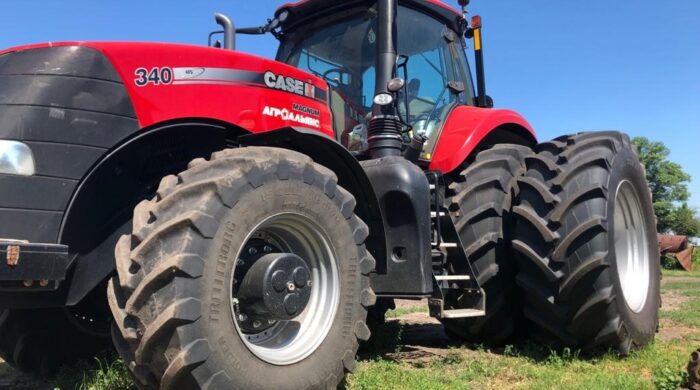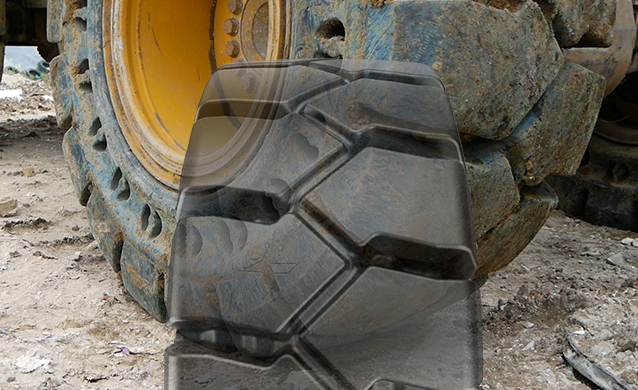What tire compounds do Solid OTR tires contain?
Solid OTR tires are built for applications working in scrap yard, recycling, waste transfer stations, demolition, CDE material recycling, and foundry. For this reason, solid OTR tires are engineered and manufactured with special compounds to resist chunking, cutting and heat, all attributes that are required by heavy-duty applications in the severe environments mentioned above. In this article, we discuss what compounds typically go into a solid OTR tire, what purpose they serve and why these compounds matter.
Let’s define what a tire compound is:
A tire compound is basically a vulcanized rubber recipe that is composed of multiple materials. Natural rubber is harvested from latex rubber trees, it goes through a complex process to make it usable in manufacturing a tire. It all depends on the base rubbers for a particular tire, but natural rubber could be used for applications that require a lot of heat resistance.
Sometimes, a more cut-resistant or wear-resistant type of tire may be required based on the application, this is when manufacturers incorporate some synthetic rubbers such as SBR or BR, derived from petroleum products. In addition, additive materials are then introduced, such as carbon black or silica, to further reinforce that rubber and provide more strength.
Consider the type of application
In this case, solid OTR tires must have high heat-resistant property in their compounds as applications that utilize solid OTR tires are typically in waste and recycling, or scrap yard. Applications in waste and recycling stations and scrap metal typically generate a lot of heat through constant, harsh working environments. Since solid OTR tires are solid, they are more resistant to cuts and chunking.
Consider how a solid OTR tire is built
While the types of compound remain essential to the durability and performance of solid OTR tires, how the tires are built and engineered plays a pivotal role as well. For example, one must consider how hard (measured in durometer) the rubber is within a solid OTR tire. A typical solid OTR contains tread rubber that is about 65-75D in hardness, and a base tread underneath the top tread, that is about 90D in hardness. Below illustrates what a typical, “2-stage” (meaning they are two stages of construction inside the tire) solid OTR contains in terms of tread rubber layers and its hardness.

In addition to the high durometer in the rubber within a solid OTR tire, manufacturers also incorporate sidewall apertures, that appear as “holes” around the tire’s sidewall. These apertures are usually defined by each manufacturer on what purpose they serve depending on the design.
While a traditional 2-stage solid OTR tire contains high durometer rubber to combat the severe environmental challenges wheel loaders face in scrap yards and waste stations, it’s beneficial to consider beyond just the high durometer rubber tread. For this reason, we engineered a 3-stage solid OTR tire that contains a three-stage construction with a specialized cut-resistant top tread, a cushion center with heat-dissipating cushion compound, and a base natural rubber layer. Below is an illustration that shows a 3-stage solid OTR tire built:

When comparing against a traditional 2-stage tire, the top tread of a 3-stage tire takes up about 50% of the tire, with a 65-70 durometer in hardness. It contains a center layer that has 65D and takes up about 25% of rubber. Lastly, the base layer, with 90D, makes up another 25%. What makes a difference in this 3-stage built is the center cushion where the sidewall apertures sit.
As mentioned above, each manufacturer defines its solid OTR apertures differently in terms of purpose. In MAXAM’s solid OTR tires, the patented “double-D” shaped apertures are positioned within the 65D center cushion, rather than being positioned within the 90D base, unlike a traditional solid OTR tire. By having the apertures sit in a lower durometer center compound, this will significantly absorb shock better than having apertures placed at the base compound.
In essence, rubber compounds within solid OTR tires are built to withstand heat, cut and chunking. While these rubber compounds make up the durometer, or hardness, that’s required for solid OTR tires, it’s always important to consider how these tires are designed and manufactured. Consider the big picture when choosing your solid OTR tires. If you’re trying to decide between a foam-filled pneumatic tire on your wheel loader versus a solid OTR tire, we discuss the differences here in this article.



